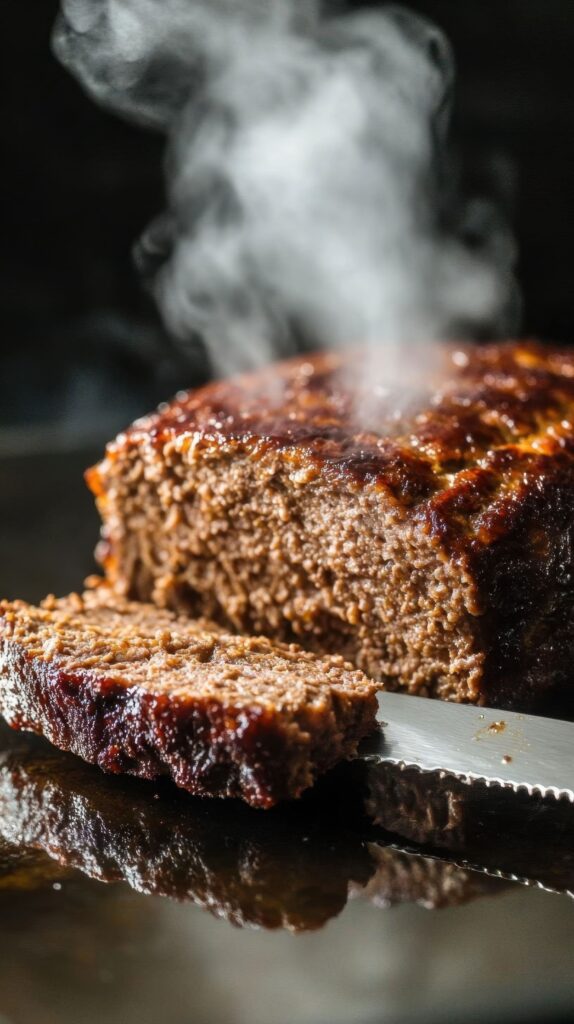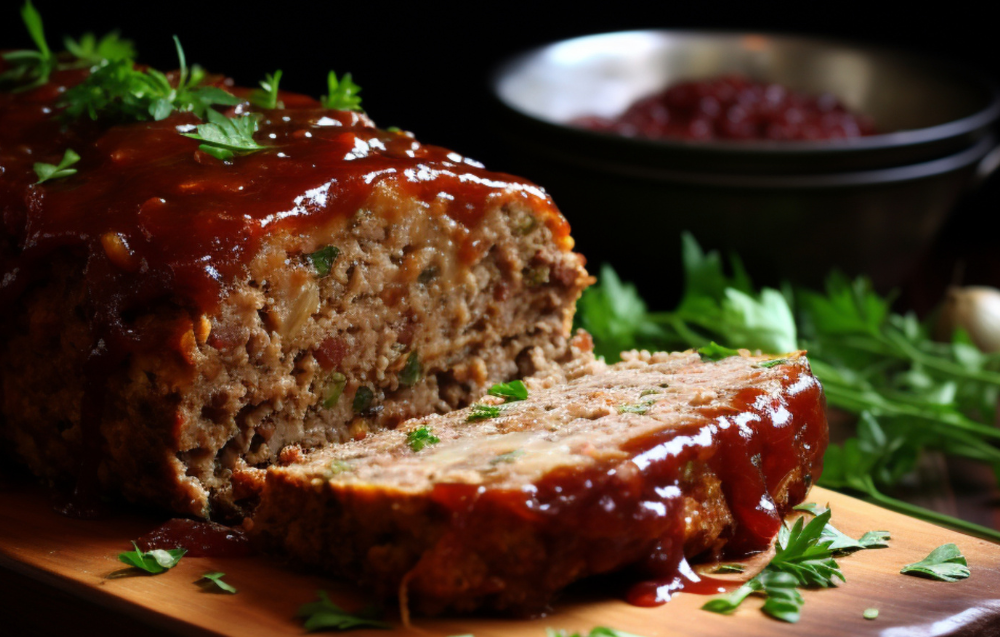Smoked Meatloaf Recipe is a classic comfort food that most of us grew up enjoying. But have you ever tried taking it to the next level by smoking it? Smoking meatloaf infuses it with rich, smoky flavors that make every bite a culinary masterpiece. Whether you’re a backyard BBQ enthusiast or just someone looking to elevate dinner, this guide will walk you through everything you need to know about creating the perfect smoked meatloaf.
Introduction to Smoked Meatloaf
Why Smoked Meatloaf is a Game-Changer
If you think of meatloaf as just a dense, baked slab of ground meat, prepare to have your mind blown. Smoking a meatloaf takes it from mundane to magnificent. Imagine the tender, juicy interior infused with just the right amount of smoky flavor. It’s not just dinner; it’s an experience. Check out these brisket sandwich recipes for more inspiration.
What makes smoked meatloaf recipe so special? It’s all about the combination of low-and-slow cooking and the addition of smoke, which transforms the ordinary into the extraordinary. The process locks in moisture while allowing the smoke to penetrate every bite. Plus, who doesn’t love an excuse to fire up the smoker?

A Brief History of Meatloaf
Before we dive into the recipe, let’s take a moment to appreciate the history of meatloaf. This dish dates back centuries and was originally a way to stretch meat supplies by mixing ground meat with breadcrumbs and spices. Over time, it became a staple in American households, known for its comforting flavors and versatility.
But the smoked version? That’s a relatively modern twist. Smoking meatloaf became popular as BBQ culture grew, blending tradition with the bold flavors we associate with outdoor cooking. It’s the perfect marriage of classic and contemporary.
“Smoking meatloaf is like giving a family favorite a backyard BBQ makeover—it’s still familiar, but with a bold new personality.”
Ingredients for the Perfect Smoked Meatloaf
Key Proteins: Choosing the Right Ground Meat
The foundation of any meatloaf is the meat. For a rich and balanced flavor, go for a mix of ground beef and ground turkey. Need more inspiration on pairing proteins? Learn from what goes well with brisket sandwiches—a treasure trove of pairing ideas that can work for meatloaf too.
Pro Tip: Use an 80/20 ratio for ground beef. The fat content keeps the meatloaf juicy during the smoking process. Too lean, and you might end up with a dry meatloaf (nobody wants that!).
Essential Add-ins: Binders, Fillers, and Flavor Enhancers
Every great meatloaf needs structure. Ingredients like breadcrumbs or crushed crackers act as the glue, while onions and garlic enhance the flavor. If you’re looking for sauce ideas to blend into the mix, check out this ultimate flavor guide for brisket sandwich sauces.
- Breadcrumbs: Traditional and effective.
- Crushed crackers: Adds a slight crunch.
- Oats: A great gluten-free option.
For binding, nothing beats eggs. They help glue the mixture together while adding richness. Aim for one egg per pound of meat.
Selecting the Perfect Seasonings and Spices
Seasonings are your chance to play. Classic spices like smoked paprika and garlic powder add depth, but don’t be afraid to experiment. For inspiration on bold seasoning combinations, explore how brisket is seasoned in this ultimate guide to sauces and flavors.
“Think of seasonings as the personality of your meatloaf. Are you going for classic and comforting or bold and adventurous?”
Additional Ingredients for Creative Twists
Feeling adventurous? Add shredded cheese for a gooey surprise in every slice or diced veggies like bell peppers and onions for extra flavor and texture. For a sweet and tangy touch, throw in a bit of BBQ sauce directly into the mixture.
Preparing the Meatloaf for Smoking
Mixing the Ingredients: Tips for Even Flavor
The trick to a well-mixed meatloaf is to combine the ingredients without overworking the mixture. Over-mixing can make the meatloaf dense and tough. Use your hands (yes, it’s messy, but so worth it!) to gently fold the ingredients until just combined.
Here’s a pro tip: Cook a small piece of the mixture in a pan to taste-test the seasoning. This ensures your flavors are spot-on before committing to the whole loaf.
Shaping and Structuring Your Meatloaf
Shape your meatloaf into a compact loaf, but don’t pack it too tightly. A firm yet slightly loose structure allows smoke to circulate and ensures even cooking. Place the loaf on a sheet of parchment paper or a cooling rack for easy transfer to the smoker.
Pre-Smoking: Resting and Refrigeration Tips
Before you toss the meatloaf into the smoker, let it rest in the fridge for 30 minutes. This step helps the flavors meld together and makes the loaf firmer, so it holds its shape better during cooking.
Smoking the Meatloaf: Step-by-Step Process
Choosing the Right Wood for Smoking
The type of wood you use can make or break your smoked meatloaf recipe. Hickory is a classic choice for its robust, smoky flavor, but cherry or applewood work well if you prefer a milder, slightly sweet smoke.
“The wood you choose is like the seasoning for your smoker—it sets the tone for the whole dish.”
Setting Up Your Smoker: Temperature and Timing
For the best results, set your smoker to 225°F, the perfect temperature for a low-and-slow cooking process that locks in flavor and moisture. Smoking a meatloaf usually takes around 2-3 hours, but the exact time depends on the size and thickness of the loaf. To ensure your meatloaf is cooked to perfection, use a meat thermometer—your most reliable tool. Insert it into the thickest part of the meatloaf and aim for an internal temperature of 160°F. This method guarantees a moist, flavorful, and safely cooked meatloaf every time, making it a standout dish at any gathering.
Monitoring the Internal Temperature for Perfection
Don’t leave your smoked meatloaf recipe to chance—use a meat thermometer to guarantee perfect results. Insert the thermometer into the thickest part of the loaf to monitor its internal temperature. The ideal point to remove it from the smoker is at 155°F, as the meatloaf will continue to cook while it rests. This resting period allows the internal temperature to rise to the safe and recommended 160°F, ensuring it’s fully cooked while retaining its juicy, tender texture. Skipping this step risks overcooking or undercooking, so take the extra time to check the temperature for a perfectly smoked meatloaf recipe every time.
Why is My Smoked Meatloaf Recipe Falling Apart?
One of the most common complaints about meatloaf—smoked or otherwise—is that it falls apart. Ever had that moment when you try to slice into it, and it crumbles into pieces? Frustrating, right?
This usually happens when there’s an imbalance of binders or the mixture hasn’t been properly combined. Eggs and breadcrumbs (or your chosen binder) are the glue that holds the loaf together. Too much or too little, and the structure collapses.
Another culprit? Not letting the meatloaf rest after smoking. When you cut into it too soon, all the juices rush out, leaving a crumbly mess.
Fix it:
- Stick to the proper binder ratio: one egg and ½ cup of breadcrumbs per pound of meat.
- Let the meatloaf rest for at least 10-15 minutes after smoking. This helps everything firm up and hold its shape.
For more insight, check out the importance of resting meat after smoking.
How to Prevent a Dry Smoked Meatloaf Recipe
Dry meatloaf is another common pitfall. Smoking can naturally dry out meat due to the long cooking process, but don’t worry—it’s totally avoidable.
The main causes of dryness are using lean meat, over-smoking, or forgetting to add moisture-retaining ingredients like onions or milk-soaked breadcrumbs. Even overpacking the loaf can squeeze out moisture.
Fix it:
- Choose meat with a higher fat content (80/20 is ideal).
- Mix in moisture-rich ingredients like diced onions or soaked breadcrumbs.
- Monitor the smoker temperature to stay steady at 225°F.
For an in-depth look at how smoking impacts moisture retention, explore the science behind smoking meat.
Dealing with Uneven Cooking Issues
Uneven cooking is a rookie mistake that can leave parts of your meatloaf undercooked while others are overdone. This usually happens when the loaf is shaped inconsistently or if your smoker has hot and cold spots.
Fix it:
- Shape the loaf into an even thickness throughout.
- Rotate the loaf halfway through smoking to ensure even heat distribution.
Want to know more about beginner-friendly smoking techniques? Learn how to choose the best smoker for beginners.
“Patience and precision are key in smoking—you’re crafting a masterpiece, not just a meal.”
Solutions to Achieve the Best Smoked Meatloaf
Tips for Moist and Juicy Results
Moisture is the heart and soul of a great smoked meatloaf recipe. Here are some tried-and-true tips to keep your loaf juicy:
- Use a water pan in the smoker. The added humidity helps prevent the loaf from drying out.
- Incorporate fat-rich ingredients. Diced meat cheese are fantastic for locking in moisture.
- Wrap it in foil. If you notice the edges browning too quickly, tent the meatloaf with foil during the last hour of smoking.
How to Add Smoky Flavor Without Overpowering
Nobody wants a meatloaf that tastes like it was rolled in a campfire. The goal is balance—a touch of smoke to complement the flavors, not dominate them.
Stick with mild woods like cherry or apple if you’re new to smoking. For a bolder flavor, hickory or pecan is perfect. Just don’t overdo it; too much smoke can make the meatloaf taste bitter.
Pro Tip: Smoke the loaf uncovered for the first hour to allow the flavors to penetrate, then cover it lightly with foil to avoid oversmoking.
Hacks for Maintaining the Perfect Shape
A beautifully shaped meatloaf not only looks great but also cooks evenly. Here’s how to keep it intact:
- Use a cooling rack. Place the meatloaf on a rack inside the smoker. It allows airflow around the loaf while keeping it stable.
- Avoid over-packing the mixture. A gentle touch goes a long way in maintaining a consistent shape.
- Refrigerate before smoking. A chilled loaf is less likely to spread out as it cooks.
Classic Smoked Meatloaf
You can’t go wrong with a traditional smoked meatloaf recipe. Stick to the classic combination of ground beef, breadcrumbs, and spices for a flavor that feels like a warm hug on a plate.
Want to keep it super classic? Top it with a sweet ketchup glaze before smoking for that nostalgic touch.
Gluten-Free and Low-Carb Smoked Meatloaf Options
For those with dietary restrictions, there are plenty of ways to enjoy smoked meatloaf recipe:
- Gluten-Free: Swap breadcrumbs for gluten-free oats or almond flour.
- Low-Carb: Use crushed meat rinds as a binder instead of breadcrumbs.
- Dairy-Free: Skip milk in the recipe and add extra veggies for moisture.
Pairing Smoked Meatloaf with Sides and Sauces
Best Side Dishes for Smoked Meatloaf
Smoked meatloaf pairs beautifully with a variety of sides. Consider these mouthwatering options:
- Mashed potatoes: A creamy, buttery classic.
- Grilled veggies: Zucchini, asparagus, or bell peppers add a fresh, smoky touch.
- Mac and cheese: Comfort food heaven when paired with meatloaf.
Sauce Recommendations: Ketchup, BBQ, and Beyond
No meatloaf is complete without a great sauce. Traditional ketchup is always a hit, but why not mix it up?
- BBQ sauce: For a smoky, tangy twist.
- Mushroom gravy: Adds a savory, earthy flavor.
- Spicy sriracha glaze: Perfect for those who like a kick of heat.
“The right sauce is like the exclamation point on your meatloaf masterpiece—it brings everything together.”
Tips for Storing and Reheating Smoked Meatloaf
Refrigeration vs. Freezing: What Works Best?
Let’s face it, smoked meatloaf leftovers are almost as exciting as the fresh dish itself. But storing it correctly is key to preserving its flavor and texture.
- Refrigeration: If you plan to eat your leftover meatloaf within 3-4 days, refrigeration is the way to go. Wrap the loaf tightly in aluminum foil or store it in an airtight container to lock in moisture and flavor.
- Freezing: Got more meatloaf than you can handle in a week? Freezing is a lifesaver. Slice the loaf into portions, wrap each slice individually in plastic wrap, and place them in a freezer-safe bag. This makes reheating smaller servings a breeze.
Pro Tip: Label and date your freezer bags. Smoked meatloaf can last up to 3 months in the freezer, but it’s easy to forget how long it’s been there!
How to Reheat Without Losing Moisture
Reheating smoked meatloaf can be tricky—nobody wants a dry, rubbery loaf. The secret? Low and slow heat.
- Oven: Preheat to 250°F, place the meatloaf slices in a baking dish with a splash of broth or water, and cover tightly with foil. Heat for 20-25 minutes, and voilà—juicy perfection.
- Microwave: For a quick fix, use the microwave. Place a slice on a microwave-safe plate, cover it with a damp paper towel, and heat in short 30-second bursts to avoid overcooking.
- Skillet: Want to get fancy? Reheat slices in a skillet over medium heat. Add a little butter or oil for a crispy, golden crust.
“Reheating smoked meatloaf is like relighting a campfire—take your time, and it’ll be just as warm and comforting as the first time around.”
Conclusion: Mastering the Art of Smoked Meatloaf
Final Tips and Tricks
By now, you’ve learned all the secrets to creating the ultimate smoked meatloaf recipe. To recap:
- Balance your ingredients for the perfect texture.
- Choose a wood that complements your flavors.
- Monitor temperature closely to avoid under or overcooking.
- Don’t rush—resting your meatloaf is just as important as smoking it.
Master these steps, and you’ll be the talk of every BBQ gathering.
Encouragement to Experiment and Personalize
The beauty of smoked meatloaf is its versatility. Don’t be afraid to get creative! Add your favorite spices, mix in unique ingredients, or experiment with different types of wood for smoking. This dish is your canvas—paint it with your own flavors and ideas.
“Every smoked meatloaf tells a story—make yours unforgettable.”
With this guide in hand, you’re ready to tackle smoked meatloaf recipe like a pro. Whether you’re feeding a hungry family or wowing guests at your next cookout, this recipe is sure to impress. So, fire up that smoker, grab your ingredients, and get ready to transform a classic comfort food into something extraordinary.

